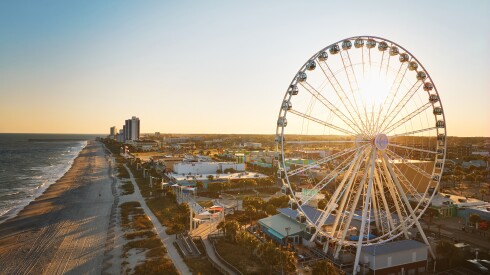Pastel colors, kitschy details, and extensive symmetry have come to define director Wes Anderson’s widely celebrated aesthetic. Films such as The Life Aquatic, Moonrise Kingdom, and The Grand Budapest Hotel are well known—and commonly loved—for transporting viewers to impeccably stylized worlds. But the popular cinematic settings dreamed up by the director have often been embellished by incredible set and costume design. Herein comes @accidentallywesanderson.
The hugely popular Instagram account spotlights destinations around the world that look like they’ve been specially crafted for one of Anderson’s film sets but are actually everyday locations that can be visited. The Instagram account’s curator, Wally Koval, created the page with his wife, Amanda, in 2017, after being inspired by a Reddit thread named AccidentalWesAnderson.

An American fireworks stand in Bastrop, Texas
Photo by Matthew Johnson, courtesy of Accidentally Wes Anderson
The travel-, architecture-, and (of course) Anderson aesthetic–enthusiast originally aimed to create an online community where people with similar interests could marvel over Anderson-inspired imagery. But Koval became increasingly curious about the stories behind these visually distinctive locations. So he shifted his focus: The account would be more than a place for Wes Anderson fans to ogle over real-life manifestations of the director’s signature aesthetic. It would also serve as an online resource where curious people could learn about unassuming locations around the world, from a powder-pink metro station in North Korea’s capital, Pyongyang, to a small fireworks stand in Bastrop, Texas.
Three years and 1.3 million followers later, the “Accidentally Wes Anderson” Instagram account continues to feature photo submissions alongside basic location details (building name, country, etc.). Each post also includes a detailed caption outlining fun facts about the particular building, interior, or landscape on display.
This fall, the elegantly curated Instagram grid even inspired a 368-page coffee-table book of the same name, which quickly—but unsurprisingly—became a New York Times best seller. With a foreword from Wes Anderson himself, Accidentally Wes Anderson (Voracious, October 2020) features 200 global locations that look like they could appear in a Wes Anderson film. The colorful images, whittled down from around 15,000 Instagram submissions, span 50 countries across every continent.

The Hotel Opera in Prague, Czech Republic
Photo by Valentina Jacks, courtesy of Accidentally Wes Anderson
The whimsical contents of Accidentally Wes Anderson provide a much-needed sense of exploration (and perhaps escapism) during a time when the COVID-19 pandemic has forced many people to put their travel plans on pause. For those who traveled frequently prior to the pandemic, the hardcover can serve as a colorful “look book” to inspire a future trip, Koval notes. For those who aren’t often on the road, Koval hopes the page will help foster the realization that you don’t need to go far to see—and learn from—amazing sights.
“Many people wouldn’t sit down and read a dense book on the history of a destination,” Koval says. “But if you put a really cool picture book together with significant facts about the place, people might do more than just learn about the location; they might be inspired to visit it themselves.”
Buy now: $32, bookshop.org
This article originally appeared online in September 2018; it was updated on December 28, 2020, to include current information.
>> Next: Around the World in 80 Books











